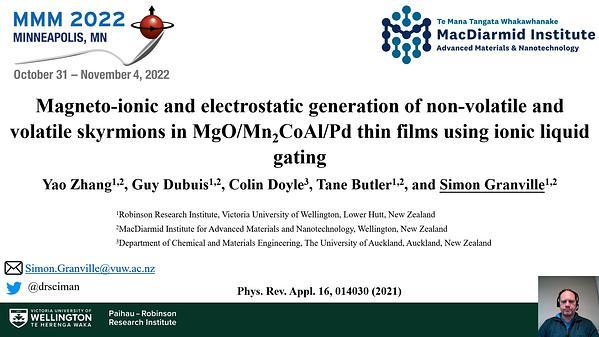
Premium content
Access to this content requires a subscription. You must be a premium user to view this content.

technical paper
Growth dependent Interlayer Chiral Exchange and Field
There are mainly two types of exchange interactions in a multiple-spins system. First being the symmetric exchange, which is directly responsible for the existence of ferromagnetism (FM) and antiferromagnetism (AFM) in which the spins collectively form either parallel or antiparallel configurations. On the other hand, the antisymmetric exchange, or the Dzyaloshinskii-Moriya interaction (DMI) 1-3 has gained significant attention lately. For the majority of cases, DMI is an intralayer effect, i.e. the nonlinear spin configurations are confined within a single magnetic layer. However, pioneering predictions 4 have recently expanded the possibility to an interlayer case, where the spins are from two distinct FM layers. We hereby demonstrate an interlayer DMI in a CoFeB/Pt/Co/Pt multilayer where CoFeB has in-plane anisotropy (IMA), while Co has perpendicular magnetic anisotropy (PMA). The wedge sputtering provides sufficient symmetry breaking for the interlayer DMI to manifest (Fig.1 (a)). A field sweep protocol involving the out of plane external field Hz sweep while applying an in-plane field Hφ with various φ orientation is used to capture the effective field experienced by the PMA layer. The resultant hysteresis loops of the Co layer are substantially shifted (Fig.1 (b)) and follow a sinusoidal form with respect to the φ direction (Fig.1 (d)). The importance of in-plane symmetry breaking is confirmed by comparing results with control samples without symmetry breaking (Fig.1 (c)). The reciprocal effect experienced by the IMA layer is captured by magneto-optical Kerr effect experiments (Fig.1 (d)). Moreover, it is shown that current-induced field-free switching of a PMA layer is achievable utilizing the DMI induced effective field and the switching polarity can be controlled by the interlayer DMI landscape (Fig.2).
References:
1 Dzyaloshinsky, A thermodynamic theory of ‘weak’ ferromagnetism of antiferromagnetics, J. Phys. Chem. Sol. 4, 241 (1957).
2 T. Moriya, Anisotropic Superexchange Interaction and Weak Ferromagnetism, Phys. Rev. 120, 91 (1960).
3 A. Fert and P. M. Levy, Role of Anisotropic Exchange Interactions in Determining the Properties of Spin-Glasses, Phys. Rev. Lett. 44, 1538 (1980).
4 E. Y. Vedmedenko, P. Riego, J. A. Arregi, and A. Berger, Interlayer Dzyaloshinskii-Moriya Interactions, Phys. Rev. Lett. 122, 257202 (2019).

Fig.1 (a) Sketch of the magnetic multilayers, external fields, coordinate system. Interlayer DMI’s manifestation on both IMA and PMA hysteresis loops presented in (b) and (d), respectively. Comparison between samples without symmetry breaking presented in (c).

Fig.2 Interlayer DMI landscape demonstrating field free switching and the influence of the device angle on the switching polarity.

